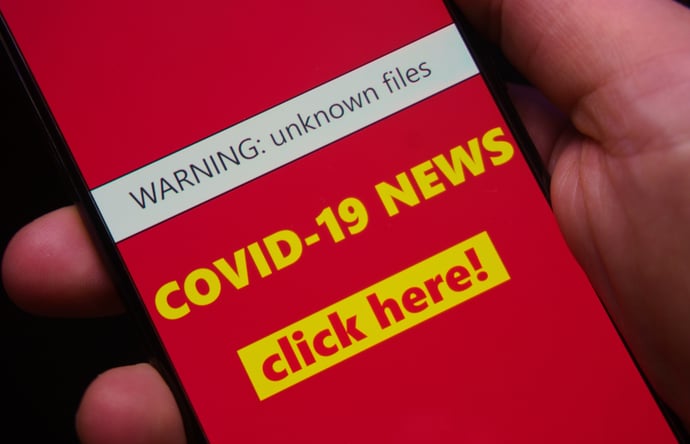COVID-19 DISINFORMATION IS ON THE RISE: HERE’S WHAT WE KNOW - Political Violence @ a Glance
by Jacob Shapiro, Kristen DeCaires, and Jan Oledan, on Apr 27, 2020 4:49:59 PM
*This article was originally published by Political Violence @ A Glance. To read the original article in full, click here. Clokair/Shutterstock.com
Clokair/Shutterstock.com
The spread of COVID-19 is being mirrored online by widely-circulated disinformation about the virus. Claims that COVID-19 came from bat soup; that holding your breath for 10 seconds can determine if you have the disease; and that it was manufactured as a bio-weapon (among others) have attracted attention from academic and civil society organizations alike. Major technology companies are ramping up operations to combat the “infodemic” on their platforms.
Concern is warranted. Health misinformation is associated with higher rates of preventable infection and ultimately death. During the Ebola outbreak, mortality rates were much higher in countries where misinformation was rampant, in part because their populations were less willing to adhere to public health guidelines. By contrast, the disease was contained in countries with strong communications strategies, such as Nigeria.
Maliciously orchestrated, deliberate campaigns are well-documented during pandemics. During the rise of HIV/AIDS, the Soviet Union launched Operation Infektion, which planted a series of fake scientific papers on the origin and transmission of the virus, and was arguably responsible for hundreds of thousands of preventable deaths and long-lasting conspiracy theories among at-risk populations. Recent reports show that Russia, along with other countries, is actively spreading disinformation about COVID-19.
Online health misinformation could have serious consequences for compliance with medical recommendations. More than 80 percent of Americans search for health information online, and an increasing number of people rely on digital sources to make health decisions. And early evidence shows there may be significant partisan gaps in social distancing, with self-identified Republicans taking fewer precautions, even after controlling for other economic and health-related factors such as local education and poverty rates and confirmed COVID-19 cases and deaths. Given how infectious COVID-19 is, even limited misinformation exposure could have disastrous results.
So what kind of disinformation is out there, and who’s propagating it? Data assembled by the Empirical Studies of Conflict Project (ESOC) at Princeton shows that most COVID-19 disinformation peddlers are spreading false narratives about a wide range of topics, from emergency responses to the nature and origins of the virus, to unproven diagnostics, cures, and preventative measures. Other narratives claim the virus was part of a country’s bio-weapons arsenal, or speculate about patient zero, celebrities, or particular groups of people.
Since March 16, the ESOC research team has gathered data from news outlets, social media posts, fact-checking websites, and individual viral posts. As of mid-April, we had identified more than 540 stories in 19 languages. Their sources range from average individuals to politically affiliated actors, to companies, media platforms, and state sponsors. Most of the disinformation narratives—about two-thirds—came from individuals rather than state sponsors, companies, or media outlets. But many of these individuals imitate official organizations, such as the Center for Disease Control, World Health Organization, or local governments, hawking false messages about lockdowns or other emergency responses.
What are the motives behind these campaigns? False narratives may be intended to stoke fear among the public, weaken or bolster the political status of particular parties, profit off of individuals, or downplay the severity of the pandemic. For example, the Fox Business Network has suggested that the new coronavirus is an “impeachment scam,” which we consider to have a political motive. China has pushed conspiracy theories accusing the US Army of bringing the virus to Wuhan, in an attempt to undermine US prestige. Various businesses in search of profit are offering “cures”—at a price.
Given the tremendous impact misinformation can have on human behavior, how concerned should we be about these campaigns? Early evidence gives reason for hope. For one, opinion about public health officials is quite positive. And although partisan news coverage may impact adherence to social distancing, evidence from past pandemics indicates that swift, non-partisan messaging from authority figures is effective in mitigating the effects of misinformation.
Although leadership in some countries is part of the problem, fact-checking websites have sprung up in a dozen countries so far, to vet news articles in near real-time, and debunk viral social media posts that spread COVID-19 narratives. ESOC is compiling a running list of these websites, as well as reports and datasets that can help researchers and the public understand the (mis)information “ecosystem.”
Consistent, clear, and accurate information is essential for stemming the tide of the pandemic. The public should be discerning; national leaders should be forthcoming, and online platforms should be vigilant. With the variance in messaging coming from leadership, objective, nonpartisan sources on disinformation are more crucial than ever.
ESOC’s work to understand pandemic disinformation—along with the work of hundreds of other social scientists, and efforts to simplify data collection and aggregate fact-checking—can help social media platforms and search engines that may inadvertently facilitate misinformation campaigns, and journalists reporting on misinformation narratives. The more we know about who spreads misinformation, why they do it, and what is the impact—the better we can respond.



